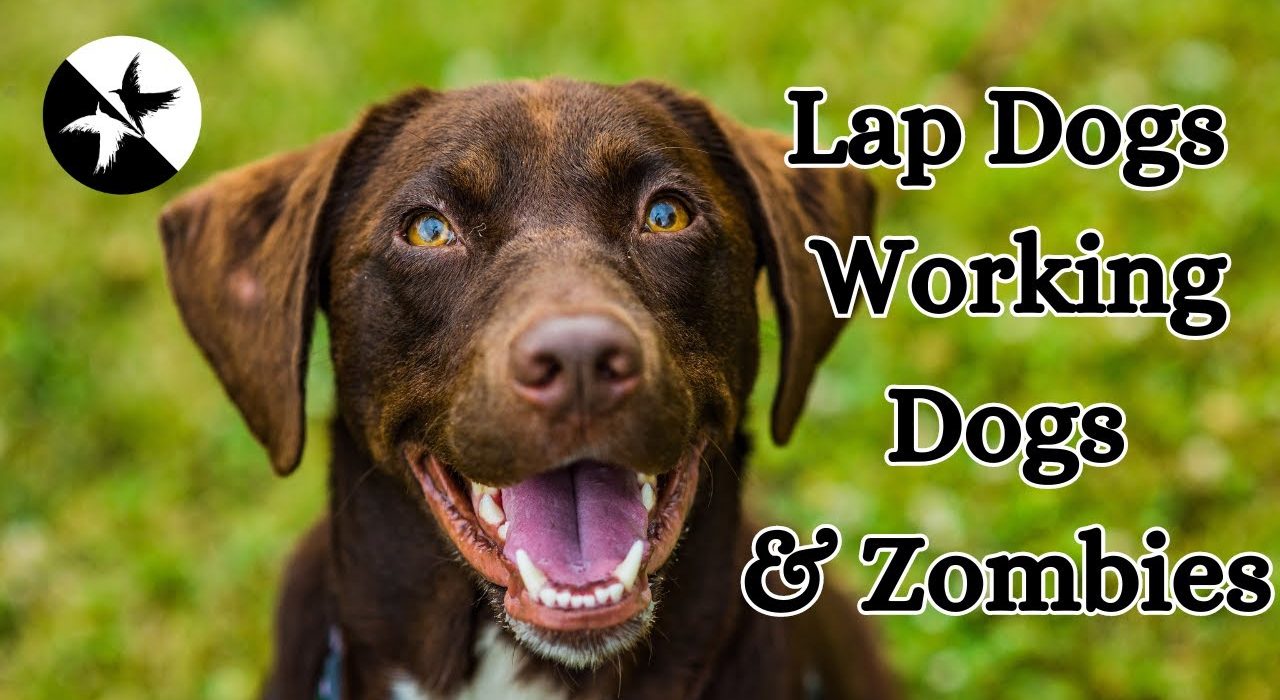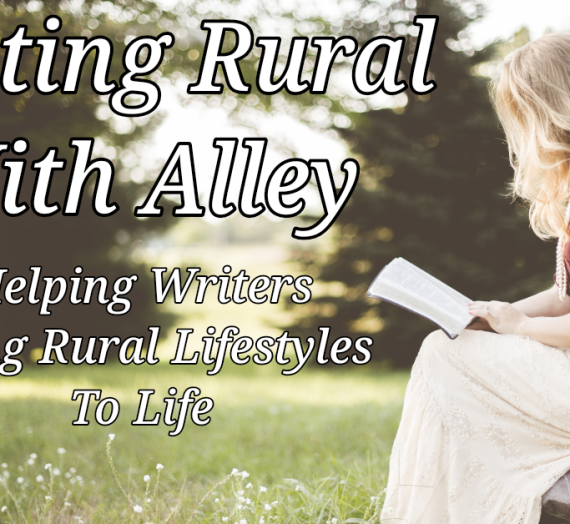What are the jobs your character could train their dog for? What are the important things to consider as you write your dog? What do working dogs have to do with milk and zombies? Find out on this episode.
Welcome to Writing Rural with Alley, the fiction writer’s inspiration station for rural life and lifestyles, from historical to post-apocalyptic, helping you bring your rural stories to life! I’m Alley, and this is episode 59, Dogs in Fiction. Stick around to the end to find out all the ways things could possibly go wrong. Now, let’s get into this.
Dog characters, whether they are the center of the story or a character’s pet, need to have a purpose in your story, even if they are just comedic relief. Man’s best friend has taken a place in stories since caveman times, which is likely when they were first domesticated, at least in my opinion. I did a Google search, and there is a crazy debate about when and where dogs were domesticated and if two types were domesticated in different sections of the earth at the same time. Honestly, I don’t know, and it really doesn’t make a difference to our stories, but if you ever need a rabbit hole, you can try to find that answer.
There are many different purposes for these dogs in our stories. Today, I will cover some. I’ll likely think of more after this episode is out at the rate new things keep popping into my head, and if so, there could be a part two. So, without further ado, let’s get into this.
Many dogs today, in history, and I assume in the apocalypse, have a job or role or, in other words, are a working dog. This can come in many shapes and sizes and with various skills. Nowadays, many families have dogs for companionship, entertaining, and teaching children responsibilities.
Companionship is not a new idea. Papillons were originally bred as lap dogs for high-ranking ladies in Europe during the 13th century. Japan had the Japanese Spaniel. In China, Pekingese was the lap dog of chose for those in the imperial palace. Although, that might be because only those who lived in the Chinese Imperial Palace were allowed to own them at the time. Here in America, many elderly women own chiweenies. They are good company for them and also do a good job sounding the alarm if someone is there that should not be, and sometimes even if they should be.
The next thing many people think about is a guard dog. Not everyone’s definition of this is the same. Some people define it as standing sentry, barking, and looking scary and intimidating. Sorry, but Grandma’s chihuahua is not scary or intimidating. In fact, most bad guys would try to punt the dog. If you don’t know what that means, it means they will try to kick it very hard. However, a Rottweiler who has enough bite force to break bones will make most people think twice about breaking into a home.
However, others define a guard dog as one that will bark, bite, and die, protecting whatever they are supposed to protect. Now, that could be scary or sad, like Lassie. Context matters when deciding what kind of guard dog to use and how far the dog would go to protect whatever they are protecting.
They might protect people, homes, junk yards, military bases, capital buildings, banks, gang or mob homes or headquarters, shipping containers, a person or group of people after the apocalypse, and more. The list is as large as your imagination.
Next up is a hunting dog. These dogs are basically track and tree animals. However, some hunters train dogs to take down the animals they are hunting. Deer is the one I have heard about most often. I’ve also heard of dogs being trained to herd wild animals, like deer, to the hunter.
This same tracking skill can and is used for tracking people. Sometimes they are tracking escaped inmates, and other times they track bank robbers. In fact, Blake Shelton did an entire song about this. However, some are trained in search and rescue in things such as avalanches, tornados, tsunamis, earthquakes, and natural or manmade disasters. This would be very useful in the aftermath of an apocalypse.
They are also used for kidnapped people, lost children, and even the elderly. Many dementia and Alzheimer patients wonder away because they think they need to be someone or meet someone and then can’t remember their way home.
Some dogs also use these tracking skills to hunt down things like truffles. I hear people can make good money selling them. Weirdly, I’ve never tried them.
Along the same line as tracking are the detection dogs. These are dogs that are trained to find certain things. Modern times include drugs, guns, bombs, and explosives as one of the main things they are used for. Other uses include bedbug infestations, cancer detection, electronics, fire accelerants, mold, termites, finding invasive or endangered species, radiation, and more.
Other types that fall under service dogs are smelling the highs and lows in people with diabetes, smelling when a seizure is about to happen, and more. They can also be trained to detect types of food or substances a person is allergic to.
Another well-known type is a cadaver dog. These dogs detect where dead bodies have been. That sounds like a really useful way to know when and where zombies are during a zombie apocalypse. A built-in doggy alarm system.
Speaking of the apocalypse, it’s going to leave a lot of traumatized people. A therapy dog or dog trained in PTSD would be a great way to cope. These dogs are trained to give noseyes, ok, it might be called nudges, but nosesys sound cuter. This is to help break flash backs, and help them stay more grounded in the here and now. This type of training is also great for abuse victims. Some have been trained to apply pressure to accomplish the same thing, and I’ll be honest, I still don’t know what applying pressure is. Let me know if you do.
Another modern type of therapy dogs include dogs trained to help people with special needs. Most often children, but adults too. Additionally, are dogs trained to sit actively, as children with dyslexia read to them. I can tell you as someone who has dyslexia, this is a struggle, and not having other people interrupting to say to you when you get it wrong can be very appreciated. Too bad there were only stuffed animals to try this one on when I was young.
On the topic of service dogs, there is the guide dog for the blind and visually impaired. They help people to navigate the world and obstacles. This could include traffic or even going to the toilet.
Then, there is a service dog for people who are deaf or hearing impaired. These dogs can alert them to sounds such as the phone, doorbell, cars, baby crying, or zombies, kind of like standing sentry with them. Each dog will be trained to meet the needs of the individual person.
The last types of service dogs are police and military dogs. These dogs can do many different things. Some will only do one type, while others do several. It depends on the dog, and their training. These can include searching for explosives, guns, USBs, IEDs, and drugs, taking down and holding criminals or suspects, taking messages or objects in places where people can not go or can’t safely go, protecting officers or soldiers, search and rescue, standing sentry, and much more.
Both police dogs and military dogs are considered working dogs. Another kind of working dog is a sled-pulling dog. Sometimes called draft dogs. If you didn’t guess it, they can pull sleds on snow or carts on dry areas. The most well-known sled dog came from Alaska in 1925 when a remote Alaskan village needed serum to treat an outbreak of diphtheria. Balto was credited with braving a blizzard and a river of thin ice to bring life-saving medicine to the village.
Other less-known but just as important ones are sled dogs for trappers and mountain men. Back before my time, when there were still milkmen, dogs were sometimes used to pull carts of milk. The carts look like smaller versions of what a horse pulls. Bread has been a well documented one that dogs have pulled in carts. This could be many things as long as it is not too heavy for the dog. The time they can pull anything depends on the weight, how long they have been pulling things, and how old they are.
The next type of working dog is a herding dog. As I said earlier, some are used to round up and herd game, like deer or elk, for hunters.
However, the most commonly known type is the sheep dog. The popularity of the movie Babe might have something to do with that. They can herd other kinds of animals; cows, reindeer and wild mustangs are common in North America. I’m sure some other countries have other animals.
While we are on the subject of herds, there is also the livestock guardian. The guardian can herd them, but their main job is to guard them. Sheep are the first thing that comes to mind. However, almost all farms with animals will have one, including us. These dogs are large, and while loving toward their people, they are not likely to be to strangers unless your character trained them to be.
These dogs can go one of two ways, guarding with surprise attacks or intimidation until force is needed. Dogs that live full time with the animals they are guarding, such as sheep, often use surprise. The dogs are often the same coloration as the sheep, so wolves and other predators do not know there is danger unless they run up on them. However, most farm dogs like ours that protect our chickens will bark to alert, and intimidate first. Only if pressed will they attack.
Live stock guardians are tough dogs. Many single-handedly take on wolf packs and run them off. Our last livestock guardian, who died of old age a few years ago, once fought a mountain lion and won! I’ve heard stories from Africa about them fighting off lions. I distantly remember a history lesson in school that shortly after rabbits were domesticated by munks, they trained dogs to guard their rabbits.
Keep in mind that the right dog breed will be important. A cane corso dog is a great protection dog for a strong handler. A Golden retriever is not so much unless your bad guy is terrified of being licked to death. A Chiweenie will not take out a mountain lion, and a great dame is not a lap dog, no matter what they think. Grandma doesn’t want a great Dane as a lap dog.
Take breeds into consideration when writing. Border Collies have a lot of energy, while bull dogs and some hounds are low energy. Don’t forget to look into that, too. Combining breeds can make for interesting mixes of the breeds’ traits.
Personality is something to take into consideration, too. Rottweilers are big and scary, but are known for what is referred to as doggy ADD. Dobermans are very intense, and it would not be easy to distract from their person as they are what is called a velcro dog. That means they like to stick to their person like velcro, as they are a one-person dog. That doesn’t mean they do not like or get along with other people, but that there is a main person they bond with.
Some dogs are confident but not leaders and will happily look to their person. Other dogs are more independent. This could be good or bad if not trained well. Some dogs are timid. This could be bad if they feel trapped as they could easily bite in fear.
Interactions with their human are important, too. If the human is scared every time the scary land lord comes over, they will either want to protect the human or hide depending on their personality. If a person always makes a big deal out of leaving home, it is likely to cause the dog to have issues with them leaving home, and they might destroy the house while they are gone. These are all things to think about.
Remember some dogs defy the breed. I have a dashhound, and I was always told how horrible they were and how they only listened when they wanted to listen. Mine listens the first time about 98% of the time, which is good for any dog. While you might think this is amazing, there are two super important things you likely don’t know. First, she is mostly blind, and somehow, I ended up being her seeing-eye person. Second, we put in a ton of time training her, and still practice a few minutes every day. Nothing intense, but enough to know I don’t need to worry she won’t listen when I need her to, for her safety. If your dog defies the odds, you most likely need a good reason.
And last but not least, many homeless people have dogs. This gives them a companion, and someone to love and care about. Many homeless people are depressed and dealing with drugs or trauma. A dog can give them a purpose to live again. Many studies show that dogs help with emotional well-being, and that can help some homeless people to get clean and sober, leave abusive relationships, and improve their lives to help improve the dogs. Other things include shared warmth on cold nights, someone to talk to, and protection. Even tiny dogs can stand sentry to bark to let the person know something is off and they need to pay attention.
Fun fact: As of 2022, it is estimated that a little over 44% of the people in the United States own dogs. Not only that, but the dog is the number one pet worldwide.
What could possibly go wrong?
Before we get to the best part, if you enjoy this podcast, I hope you’ll take a minute to follow, rate, and review on your podcasting platform. And if you are listening on YouTube, subscribe and hit that like button. Don’t forget to share with a friend. Now for everyone’s favorite part!
Likely to go wrong: Your character’s little lap dog things it is a protection dog, and barks at everything. One day, a bigger dog attacks it after being barked at. The dog could be injured and require veterinarian care.
Likely to go wrong: Your character works with a police dog. One day they send the dog after a bad guy, and when the dog bites them, they instinctively try to get the dog off by hitting it. The dog could be hurt and require veterinarian care.
Possible to go wrong: Your character has a seizure-alert dog. One day, at the store, a disrespectful parent lets their young child pet the dog. While the dog is paying attention to the child, it misses the signs that your character is going to have a seizure. Just as the child finishes, the character has a seizure right in front of the child, and it traumatizes them.
Possible to go wrong: Your homeless character has a dog. One day, an uncaring animal control officer takes the dog away simply because the person is homeless. This could be devastating for both your character and the dog.
Possible to go wrong: Your character’s livestock guardian dog fights off a pack of wolves and is injured in the process. Your character will need to get them veterinary help or care for them themselves.
Unlikely to go wrong: Your character’s dog is pulling a milk cart half full of milk when something spooks them. They could run off, or startle in a way that tips the cart over, spilling all the milk.
Unlikely to go wrong: Your character’s bomb-sniffing dog gets too close to the bomb and accidentally detonates it. This could be deadly.
Unlikely to go wrong: Your character is stealing sheep. As they try to round sheep up to take away, the live stock guardian dog attacks them.
Improbable but still technically in the realm of possibilities: Your character’s sled dog has worked its way up to lead sled dog. However, they are not as good at this as the handler believed, and they lead the team off a cliff.
Improbable but still technically in the realm of possibilities: Your elderly character owns a great Dane, who thinks it is a lap dog. One day it knocks them over, and they brake a hip.
Improbable but still technically in the realm of possibilities: Your character’s cadaver dog is in the zombie apocalypse, but now there are so many dead zombies that everything smells dead to the dog. They no longer know when to signal and when not to signal.
Thanks for listening! You can find the show notes and helpful links to learn more on my website, alleyhart.com. That’s A-L-L-E-Y-H-A-R-T.com. Subscribe or follow for more episodes. Connect by dropping me a comment on my YouTube videos. A new episode comes out every Monday. Until then. Happy wordsmithing.
Helpful links to learn more:


